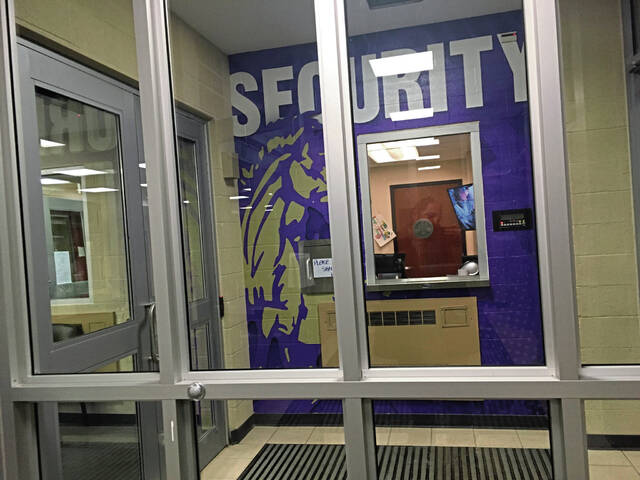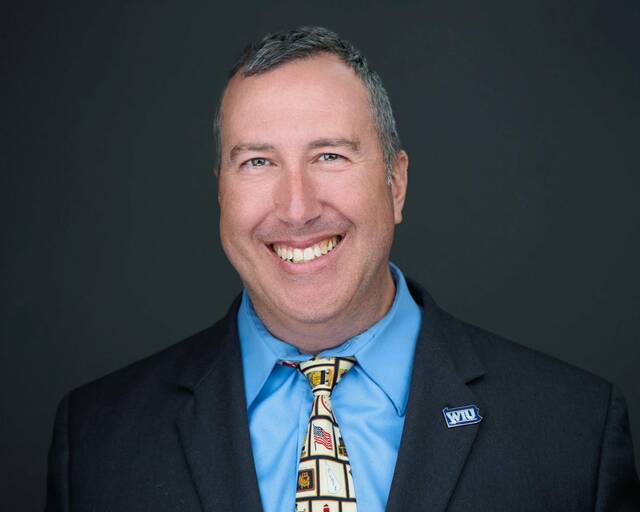'Those lost lives can help prevent future lost lives': Western Pa. schools are rethinking security, experts say
Door locks. Secure entrances. Ballistic window film. Security cameras. Metal detectors.
As threats and incidents of violence become more common at schools across the country, educators are seeking out building upgrades to enhance student safety.
But to school safety and security expert Aaron Skrbin, talking is the more important first step.
“The point in all of this is we need to spend the time to talk about the terrible things — to talk about the school shooting,” he said, “and to take the time to prepare for them.”
Preparing for emergencies could not be more important than it is right now, said Skrbin, director of safety and security for the Allegheny Intermediate Unit.
Nearly 160 students were killed in active shooter incidents in schools from 2000 to 2022, according to the National Center for Education Statistics. More than 80 school shootings were recorded in 2023, Pew Research Center data says.
This year there have been 33 school shootings that injured 48 people and killed 15, according to a report by Education Week. About half of the deaths were students.
Schools also have been the subject of unfounded threats. There were at least nine threats of violence reported by local districts across a week-long span in September that garnered the attention of the FBI — none of which were deemed credible.
What schools are doing
There is no one right way to design secure, safe schools.
The International Building Code does not contain security requirements for schools, said Architect Elijah Dolly.
And Joe Rice, safety and security coordinator for the Westmoreland Intermediate Unit, has seen schools find success with different security measures.
Open school designs, for example, are suitable for collaborative work and maintain lines of sight, but they provide little coverage in the event of a violent incident, Rice said. Conversely, a space with concrete walls might be bulletproof but create difficulties with cell service.
“I wouldn’t say there’s one thing that everybody’s doing that’s the best,” Rice said. “I would say there’s a lot of different things, and different people have opinions on it.”
But Western Pennsylvania school districts are amping up security with modern school safety designs and protective tools.
Even devices as simple as classroom door locks are being reworked to specifically protect students from intruders.
“There’s a lot that’s being done with door hardware these days that has been invented or beefed up at least in the last five to 10 years in lieu of a number of recent events,” he said, referring to the rise in school violence.
“That has to do with better security for teachers in how the door operates (and) also … limiting the views (into) the classroom,” said Dolly, who works for Buchart Horn Architects in Pittsburgh’s Strip Distict.
Constructing a new building is an easy opportunity to upgrade security measures, Dolly said, but steps can be taken to enhance safety through renovations.
Though rare in schools built in the mid-2000s, mouse trap entrances are popping up at new and renovated buildings, Skrbin said. This design holds visitors in an enclosed area while their identity is verified before they are cleared to enter the building.
School architects also are starting to shift away from large glass walls because of safety risks, Skrbin said.
The concern is not just with potential school shootings, he said. Glass may not be durable enough to withstand severe storms.
“We had more tornadoes in Southwestern Pennsylvania this spring than I can recall ever having in one season here in my lifetime,” he said.
Five tornadoes touched down across Western Pennsylvania in June — damaging homes, uprooting trees and downing power lines.
Most modern schools are designed with clean lines, eliminating blindspots and hiding places, Skrbin said.
“I worked at a school at one point in my career that was round. … There were no corners, you couldn’t see anything, and it had over 100 exterior doors,” he said. “It was a nightmare to attempt to secure that building. But that was the design craze, a design element I guess, of the ‘70s.”
Security gadgets
Tools like metal detectors are becoming more common, Skrbin said.
Hempfield Area has spent nearly $215,000 since July to install a dozen metal detectors at its high school entrance.
Security upgrades have been discussed by the district since October, when three high school students were caught exchanging two loaded handguns on a bus and in a school bathroom. The district formed a safety committee in response.
Franklin Regional announced in February it would install similar weapons detection systems at its senior high and middle school.
But that doesn’t mean they are right for every school.
“That, to me, is a very internal decision,” he said, noting he sees a 50-50 split in schools using the technology. “That is something that each school really needs to consider on their own.”
Skrbin also has seen schools install security cameras with facial recognition capabilities and ballistic-style window film for an added layer of protection.
Cost plays a role in decisions to increase security measures, Skrbin said. Price tags on metal detectors range from $18,000 to $25,000 per unit, and upgrading school buildings comes with a host of responsibilities.
“Let’s say you take a building built more than 30 years ago. As soon as you touch that building, everything has to come up to code with ADA, which can be very expensive,” he said. “Then you have to look at how you can make the building more environmentally-friendly. … And then you start adding in all these physical security measures that you can build into construction, and that adds another layer of cost to it.”
State grants can ease the financial burden, he said.
Gov. Josh Shapiro allocated in August nearly $120 million to support safety and mental health in the state’s schools.
“In some cases, that might be enough to get you what you need — maybe even a little bit more than that,” he said. “But the thing is once you buy it, then you have to maintain it and, at some point, you have to upgrade it. You have to budget smart for these things.”
But without a proper emergency plan, building upgrades and technology investments fall short, Skbrin said.
“You can spend a million dollars on security and you have a secure school in the sense that nobody can get in, your doors are locked, you have window film, metal detectors,” he said. “But if you’re not focusing on those relationships, that suggests you don’t have the safest school, though it would be secure.”
Compiling a threat assessment team and response plan are good places to start, Skrbin said.
Schools also can work with organizations including state police to complete a risk and vulnerability assessment of their buildings, Rice said, which can generate ideas for security improvements.
Student mental health
With suicidal thoughts often tying to violent behavior, emergency preparation and student mental health support go hand-in-hand, Rice said.
“We do a much better job today at recognizing students and people who might be heading in that direction than we have ever done,” said Rice, a mental health first aid trainer.
Anxiety is the highest growing mental health concern Rice sees among Westmoreland County students — and the diagnoses are coming at much younger ages. Behavioral disorders such as ADHD are also common, and mood disorder diagnoses like depression are much higher than before the pandemic, Rice said.
About 50 million Americans are experiencing a mental illness and more than 2.7 million youth are diagnosed with severe major depression, according to a 2023 report by Mental Health America.
More than 200 people died by suicide in Allegheny County in 2023. Westmoreland saw 60 suicide-related deaths that year, according to Coroner Tim Carson.
More schools are investing in mental health counselors to help address the issue, Rice said.
“Our teachers didn’t go to teacher school to be mental health professionals. That doesn’t mean they want to ignore the problem,” he said. “They’re just not trained to be able to address the problem, whereas someone with that specific training, if we can have him or her in the building, it provides a lot more support for our kids.”
Educators or school staff who identify a potential mental health concern in a student can request they be screened for suicidal thoughts and ideation, he said.
Students can also benefit from anti-bullying clubs, he said, and programs like Rachel’s Challenge — created by the parent of a student killed in the 1999 Columbine High School shooting.
Related:
• Experts say focus on mental, behavioral health paramount in combating school threats
School-student relationships
No matter what security upgrades a district decides to make, its community should be involved in the process, Skrbin said.
“I think you have to be transparent — with your kids, with your staff, with your community,” he said.
“There’s no reason not to be up front about the kinds of things you’re doing and talking about why you’re doing it. And in some cases, you can engage the community, engage kids as part of that conversation.”
Superintendents can host panels with members of student council to gather feedback on school safety and potential security improvements. Those enrolled in video production classes can create news packages teaching the student body about safety protocols.
Platforms such as Safe2Say Something also bring students into the conversation, Rice said — providing them a way to report suspicious behavior and opening a safety dialogue with their teachers.
“These past events are terrible. I wouldn’t wish them on anybody, but if we don’t learn from them and we don’t grow from them,” Rice said, “then they’re wasted opportunities and wasted lives.
“Those lost lives can help prevent future lost lives. So let’s learn from it.”
Quincey Reese is a TribLive reporter covering the Greensburg and Hempfield areas. She also does reporting for the Penn-Trafford Star. A Penn Township native, she joined the Trib in 2023 after working as a Jim Borden Scholarship intern at the company for two summers. She can be reached at qreese@triblive.com.
Remove the ads from your TribLIVE reading experience but still support the journalists who create the content with TribLIVE Ad-Free.



